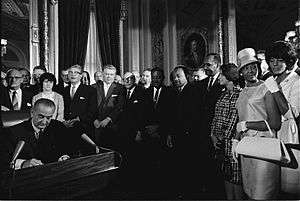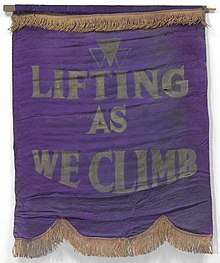Black suffrage in the United States
The history of black suffrage in the United States, or the right of African Americans to vote in elections, has had many advances and setbacks. Prior to the Civil War and the Reconstruction Amendments to the U.S. Constitution, some blacks in the United States were given the right to vote, but this right was often abridged or taken away. After 1870, blacks were theoretically equal before the law, but in the period between the end of Reconstruction era and the passage of the Civil Rights Act of 1964 this was frequently infringed in practice.

Background
%2C_Harper's_Weekly.jpg)
At the founding of the country, blacks were not given citizenship or the right to vote. Early legal acts, like the Naturalization Act of 1790, granted naturalized citizenship to "free white person[s] ... of good character", thus excluding slaves, free blacks, Native Americans, indentured servants, and Asians.[1][2] However, states were allowed to grant voting rights at the state level. Prior to the Civil War, free blacks had suffrage in New York, New Jersey, and Pennsylvania. However, the right to vote was rescinded in New Jersey (1807)[3] and Pennsylvania (1838).[4] During this time, Abolitionists sought an end to slavery, and many demanded further rights such as suffrage. The 1857 Dred Scott case held that persons of black descent were not U.S. citizens.
After the Civil War, Reconstruction Era laws favored black suffrage, but in practice, blacks still faced obstacles to voting. Some of the "Black Codes" passed shortly after the legal abolition of slavery explicitly prevented blacks from voting. The Fifteenth Amendment to the United States Constitution, adopted in 1870, stipulated: "The right of citizens of the United States to vote shall not be denied or abridged by the United States or by any State on account of race, color, or previous condition of servitude." The Enforcement Acts increased federal penalties for voter intimidation, particularly by white terrorist groups such as the Ku Klux Klan.[5]
Blacks seeking suffrage were often met with violence and disenfranchisement. The 1873 Colfax massacre occurred when white locals fought with blacks and federal troops over black voting in Grant Parish, Louisiana. In United States v. Cruikshank (1876), the U.S. Supreme Court invalidated some of the Enforcement Acts, ruling that the federal government could only intervene to prevent discrimination by state actors. In United States v. Reese (1876), the Court upheld voting requirements, such as literacy tests, which do not explicitly discriminate on the basis of race. Jim Crow laws enforcing legal racial segregation at the state and local level in the Southern United States[6] were enacted in the late 19th and early 20th centuries by white Democratic-dominated state legislatures to disenfranchise and remove political and economic gains made by blacks during the Reconstruction Era.[7]
Blacks continuously worked towards overcoming these barriers. A group of black activists formed the Niagara Movement in 1905, rebuking the Atlanta compromise and issuing a declaration that demanded universal manhood suffrage. The National Association for the Advancement of Colored People formed in 1910 and pursued voting rights mostly through litigation. In Guinn v. United States (1915), the Supreme Court struck down a grandfather clause that functionally exempted only white people from literacy tests. The Court ruled against white primaries in Nixon v. Herndon (1927) and Nixon v. Condon (1932), upheld white primaries in Grovey v. Townsend (1935), and finally banned them with Smith v. Allwright (1944) and Terry v. Adams (1953). In Breedlove v. Suttles (1937), The Court upheld the constitutionality of a poll tax requirement for voting.[5]
The Civil Rights Movement brought renewed attention to black voting rights. Florida voting rights activists Harriette Moore and Harry T. Moore were assassinated by the KKK in 1951. In Gomillion v. Lightfoot (1960) the Supreme Court struck down a plan to redraw the district lines of Tuskegee, Alabama, on the grounds that it would disenfranchise black voters. The Twenty-fourth Amendment to the United States Constitution, passed in 1962–1964, banned poll taxes as a precondition for voting in federal elections. The Supreme Court ruled against state poll taxes in 1966 in Harper v. Virginia State Board of Elections.[5] Civil rights leaders began organized campaigns to register black voters, including the federally endorsed Voter Education Project. A particularly intense voting rights struggle in Mississippi led to the death of Medgar Evers in 1963 and the Freedom Summer campaign in 1964. Organizers also created the Mississippi Freedom Democratic Party to challenge the white-dominated Mississippi Democratic Party. In Alabama, the highly publicized Selma to Montgomery marches in 1965 met with a violent response, bringing more scrutiny to suppression of black voters. The Voting Rights Act of 1965 prohibited a range of discriminatory state voting practices. The Supreme Court upheld this law in the 1966 decision South Carolina v. Katzenbach.[8]
Since the 1960s, the practice of gerrymandering and the creation of "majority minority" districts have sometimes been identified as threats to black voting rights in the U.S.[9] The Supreme Court limited the Gomillion decision in Mobile v. Bolden (1980), distinguishing between racist effects and racist intent, and prohibiting only the latter. The Court ruled in Shaw v. Reno (1993) that if a redistricting plan is "so bizarre on its face that it is 'unexplainable on grounds other than race'", it must be held to a "strict scrutiny" standard under the Fourteenth Amendment. The Court has since struck down redistricting plans for racial gerrymandering in Miller v. Johnson (1995), Bush v. Vera (1996), and several more cases.[10] The Supreme Court struck down part of the Voting Rights Act in Shelby County v. Holder (2013), holding that the racist practices that necessitated the law in 1965 no longer presented a problem in 2013.[6]
Black women's suffrage movement

Black women began to work for political rights in the 1830s in New York and Philadelphia.[11] Throughout the 19th century, black women like Harriet Forten Purvis, Mary Ann Shadd Cary, and Frances Ellen Watkins Harper worked on black civil rights, like the right to vote. Black women had to fight for racial equality, as well as women's rights. They were often marginalized because of their race and their gender.[12] This led to the creation of groups like the National Association of Colored Women. Black women gained the legal right to vote with the passage of the Nineteenth Amendment to the United States Constitution in 1920. With women gaining the vote, and the passage of the Civil Rights Act, black women became a powerful voting block.[13]
See also
- 1869 Convention of Colored Citizens of Minnesota
- The Ballot or the Bullet
- Black nationalism
- Racial Equality Proposal, 1919
- Mary Church Terrell
- Universal suffrage
- Women's suffrage
References
- Hymowitz; Weissman (1975). A History o Women in America. Bantam.
- Schultz, Jeffrey D. (2002). Encyclopedia of Minorities in American Politics: African Americans and Asian Americans. p. 284. ISBN 9781573561488. Retrieved March 25, 2010.
- "The American Revolution". www.nps.gov. Retrieved March 20, 2020.
- "Black Philadelphians Defend their Voting Rights, 1838". The American Yawp Reader. Retrieved March 20, 2020.
- Swinney, Everette (1962). "Enforcing the Fifteenth Amendment, 1870–1877". Journal of Southern History. 28#2 (2): 202–218. doi:10.2307/2205188. JSTOR 2205188.
- Fremon, David (2000). The Jim Crow Laws and Racism in American History. Enslow. ISBN 0766012972.
- Bruce Bartlett (January 8, 2008). Wrong on Race: The Democratic Party's Buried Past. St. Martin's Press. pp. 24–. ISBN 978-0-230-61138-2.
- Finkelman, Paul (2010). South Carolina v. Katzenbach. Milestone Documents in African American History: Exploring the Essential Primary Sources. 4. Dallas, Tex: Schlager Group. OCLC 500822815.
- Li, Michael; Royden, Laura (October 17, 2017). "Does the Anti-Gerrymandering Campaign Threaten Minority Voting Rights?". Brennan Center.
- See: Category:United States electoral redistricting case law
- Gordon, Ann D. (1997). African American Women and the Vote 1837-1965. Amherst: University of Massachusetts Press. pp. 2, 27. ISBN 1-55849-058-2.
- Giddings, Paula J. (1984). Where and When I Enter... The Impact of Black Women on Race and Sex in America. New York: William Morrow. pp. 64–83. ISBN 0688019439.
- Jones, Martha S. (2020). Vanguard: How Black Women Broke Barriers, Won the Vote, and Insisted on Equality for All. New York: Basic Books. ISBN 9781541618619.
Further reading
- Bateman, David (2020). "Partisan Polarization on Black Suffrage, 1785–1868". Perspectives on Politics. 18 (2): 470–491. doi:10.1017/S1537592719001087.
- Bateman, David (2018). "Disenfranchising Democracy: Constructing the Electorate in the United States, the United Kingdom, and France". Cambridge: Cambridge University Press. ISBN 9781108470193. Cite journal requires
|journal=(help) - Robinson, George M. Fredrickson Edgar E. (1995). Black Liberation: A Comparative History of Black Ideologies in the United States and South Africa. Oxford University Press. ISBN 978-0195109788.
External links
- "How the Suffrage Movement Betrayed Black Women".
- "How Black Suffragists Fought for the Right to Vote and a Modicum of Respect". Cite journal requires
|journal=(help) - "Votes for Women means Votes for Black Women".
- "Weekend Read: Challenging the whitewashed history of women's suffrage".
- "The 19th Amendment Only Really Helped White Women".